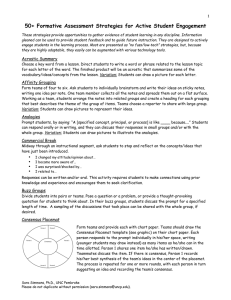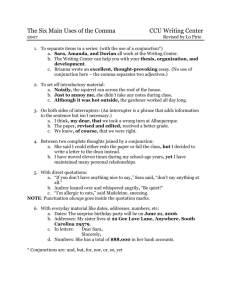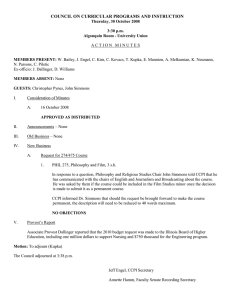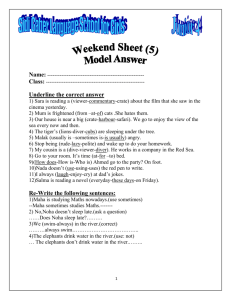Standards Standards--Aligned Instruction: Aligned Instruction: Purposeful and Powerful
advertisement
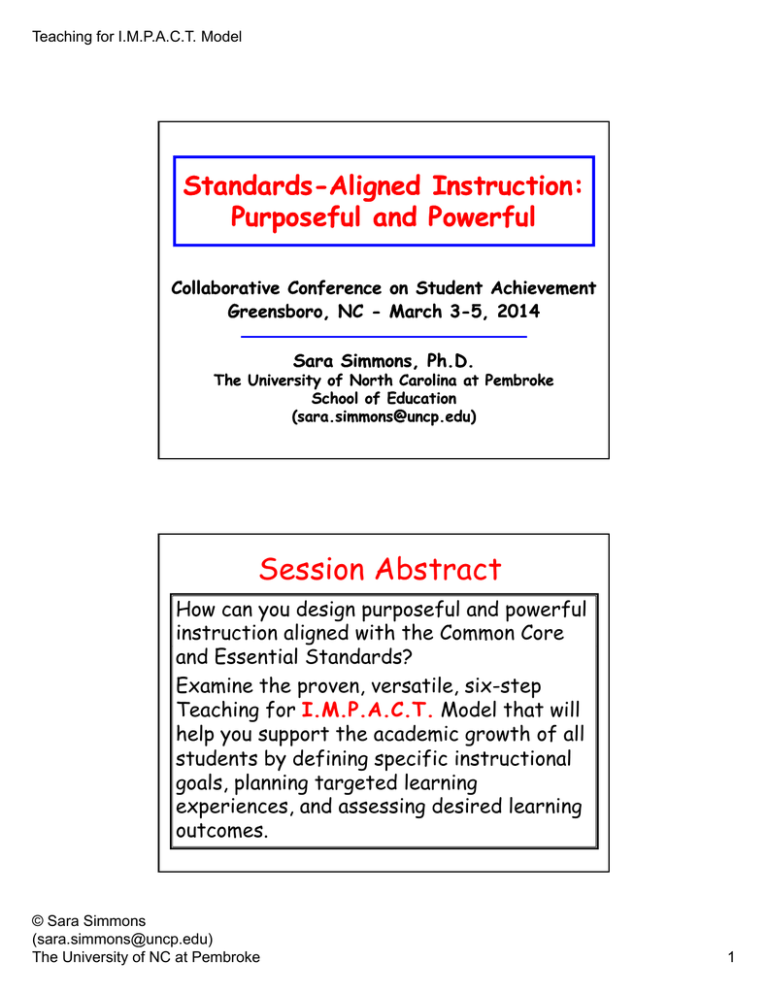
Teaching for I.M.P.A.C.T. Model Standards-Aligned Instruction: StandardsPurposeful and Powerful Collaborative Conference on Student Achievement Greensboro, NC - March 33-5, 2014 Sara Simmons, Ph.D. The University of North Carolina at Pembroke School of Education (sara.simmons@uncp.edu) Session Abstract How can you design purposeful and powerful instruction aligned with the Common Core and Essential Standards? Examine the proven, versatile, six-step Teaching for I.M.P.A.C.T. Model that will help you support the academic growth of all students by defining specific instructional goals, planning targeted learning experiences, and assessing desired learning outcomes. © Sara Simmons (sara.simmons@uncp.edu) The University of NC at Pembroke 1 Teaching for I.M.P.A.C.T. Model Session Objectives You will: • become familiar with the Teaching for IMPACT inst instructional ti n l d design si n m model d l for f planning pl nnin effective ff ti standards-based units of study; • learn how to use a practical, teacher-friendly template to develop a unit; • synthesize what you have learned by reviewing a flowchart of the model; • have an opportunity to deepen your understandings about standards, curriculum, assessment, and instruction, and • reflect on your own practice. Seminar Agenda • Reflection: Self-Assessment • Brief Update CCSS & NCES What the NCES and CCSS do/do not mandate for schools and teachers • Overview: The 6-step Teaching for IMPACT Model • Interactive Demonstration: Applying the Model • Closure © Sara Simmons (sara.simmons@uncp.edu) The University of NC at Pembroke 2 Teaching for I.M.P.A.C.T. Model Teaching for IMPACT Identification of Goals Mapping the Essentials Planning for Assessment Activities for Learning Consideration of Diversity Teaching for Understanding Teaching for IMPACT R sults Results Evidence Learning Plan © Sara Simmons (sara.simmons@uncp.edu) The University of NC at Pembroke Identification f of f Goals Mapping the Essentials Planning for Assessment Activities for Learning Consideration of Diversity Teaching for Understanding 3 Teaching for I.M.P.A.C.T. Model Identification of j Goals/Objectives What sources do I need to consider? • CCSS and State (NCES) Standards • LEA Expectations • Students Mapping the Essentials How do I establish curricular priorities? • Enduring Understandings • Essential Questions • Knowledge, Skills, Dispositions © Sara Simmons (sara.simmons@uncp.edu) The University of NC at Pembroke 4 Teaching for I.M.P.A.C.T. Model Planning for Assessment How will I know if students understand? • Types of Evidence • Criteria for Evaluation • Scoring Tools Activities for Learning How do I teach for understanding? • Sequence of Learning Experiences • Methods of Instruction • Resources and Materials © Sara Simmons (sara.simmons@uncp.edu) The University of NC at Pembroke 5 Teaching for I.M.P.A.C.T. Model Consideration of Diversity How do I address learner differences? Differentiation through consideration of: • Readiness • Learning Styles • Interests • Content • Products • Activities and… • Modifications for Special-Needs Students Teaching for Understanding How do I ensure that students REALLY understand? • Common Core State Standards • NC Essential Standards • Bloom’s Revised Taxonomy © Sara Simmons (sara.simmons@uncp.edu) The University of NC at Pembroke • Marzano’s Taxonomy • Six Facets of Understanding (Wiggins & McTighe) • Depth of Knowledge (DOK) 6 Flowchart – Teaching For IMPACT Identification of Goals Which standards? Local CCSS State Mapping of Essentials What big ideas are worthy of understanding? Enduring Understandings What questions might guide inquiry into the important ideas? Essential Questions What should students know, understand, be like, and be able to do? Knowledge, Dispositions, Skills Planning of Assessments Performance Tasks Academic Prompts Consideration of Diversity Types of Evidence Observations Criteria for Evaluation Teaching for Understanding Scoring Tools Activities for Learning What to Teach How to Teach Sequence Resources/Materials ©S.C. Simmons, PhD, sara.simmons@uncp.edu Please do not duplicate without permission. Quizzes/Tests Self-Assessments “Teaching for IIM MPPA ACCT T” Template Use this page to guide your unit planning as you apply the “Teaching for I IM MPPA ACCT T” model. ________________________________________________________________________________________________ IIdentification of Goals: What SOURCES do I need to consider? Common Core State Standards y y State Standards (including technology standards) y y Local Expectations y y ________________________________________________________________________________________________ M Mapping the Essentials: How do I establish curricular PRIORITIES? Enduring Understandings y y Essential Questions y y y Knowledge y y y y Dispositions y y y y Skills y y y y ________________________________________________________________________________________________ PPlanning for Assessment: What is the EVIDENCE of understanding? [See the next page to consider learner differences and teaching for understanding as you plan.] Types of Evidence (e.g., diagnostic, formative, and summative assessments such as performance tasks, academic prompts, quizzes/tests, informal checks for understanding, student self-assessments and reflections) y y y y Criteria for Evaluation of Each Type of Evidence (e.g., what is valued and/or required) y y Scoring Tools (e.g., rubrics, checklists) y y _____________________________________________________________________________________ ©S. C. Simmons, 2005 (revised 2014) Please do not duplicate without permission. ( sara.simmons@uncp.edu) “Teaching for IIM MPPA ACCT T” Template (continued) _____________________________________________________________________________________ A Activities for Learning: HOW do I teach for understanding? [See below to consider strategies for differentiation and monitoring for understanding as you plan.] Sequence of Learning Experiences and Methods of Instruction 1. 2. 3. 4. 5. 6. 7. 8. 9. 10. Resources and Materials (for students and teacher) y y y y y _____________________________________________________________________________________ CConsideration of Diversity: How do I address LEARNER DIFFERENCES? Diverse Learner Needs • • • • • Strategies for Differentiation • • • • • _____________________________________________________________________________________ T Teaching for Understanding: How do I ensure that students REALLY understand? _____________________________________________________________________________________ ©S. C. Simmons, 2005 (revised 2014) Please do not duplicate without permission. ( sara.simmons@uncp.edu) Ideas/Strategies for Modifying Content, Products, and Process In Response to Learner Readiness, Interests, and Learning Profiles MODIFYING CONTENT (CURRICULUM) Characteristic Readiness Interest Learning Profile y y y y y y y y y y y y y y y y y y y y y Ideas/Strategies Provide texts and supplementary materials of varying reading levels and text complexity Reteach students who are having difficulty Demonstrate ideas or skills as well as talking about them Make available audio-recorded materials Use videos to support presentations of information Highlight key sections of text for learners who need extra support Assign buddies who will work together to read texts or supplementary materials Provide graphic organizers and/or study guides for note-taking Provide lists of key academic vocabulary for reference Utilize surveys and questionnaires to determine student interests Design interest centers to encourage further exploration of topics and/or enrichment Provide a wide range of materials on a wide range topics of interest to students Solicit student input to guide selections of topics and materials Use examples and illustrations based on student interests Use auditory, visual, and kinesthetic modes in presentations Base examples, illustrations, applications on varied intelligences (e.g., Gardner, Sternberg) Use teaching methods that include both whole-to-part and part-to-whole approaches Use wait time MODIFYING PRODUCTS (EVIDENCE OF LEARNING) Characteristic Readiness Interest Learning Profile Sara Simmons, Ph.D. UNC at Pembroke (revised 2014) Ideas/Strategies Use tiered product assignments (different levels of difficulty, but same key learning goals) Provide directions for products that are more specific for some, more open for others Provide bookmarked Internet sites at different levels of difficulty as resources Provide teacher-led mini-workshops on various facets of product development to support student work y Form critique groups that are both similar-readiness and mixed-readiness during product development y Develop rubrics based on both grade-level requirements and individual needs y y y y y y y y y y y y y y Allow for student choice in product development or choice of product Provide a wide range of media and materials to use in development of products of learning Encourage students to demonstrate their learning in related topics of special interest Allow students to develop independent investigations with appropriate guidance Provide product options that allow students to tap into varied learning preferences Provide opportunities for students to work together or alone on product development Develop product options that incorporate a wide range of student cultures/communities 1 Ideas/Strategies for Modifying Content, Products, and Process In Response to Learner Readiness, Interests, and Learning Profiles (continued) MODIFYING PROCESS (LEARNING EXPERIENCES) Characteristic Readiness Ideas/Strategies y Provide scaffolding as students engage in reading, writing, and speaking grounded in evidence from texts Use tiered activities (different levels of difficulty, but same key learning goals) Make directions for tasks more specific for some, more open for others Provide resource materials at varied levels of readability and text complexity Provide teacher-led mini-workshops as needed to support student work Form both like-readiness and mixed-readiness work groups Define criteria for success based on whole-class requirements as well as individual needs Provide second language learners with materials in their primary language Assign in-class activities and homework based on readiness levels Vary the pacing of student work Interest y y y y y y y y y y y Provide ample opportunities for students to apply knowledge and skills to solve real-life problems y Form interest-based discussion groups y Use both like-interest and mixed-interest work groups y Utilize the jigsaw cooperative learning strategy to allow students to become “experts” in Learning Profile y y y y y y y topics of interest to them Allow students to design or to help with designing some tasks Allow multiple options for how students process their learning Provide opportunities for students to work together or independently Vary work arrangements to provide competitive, collegial, and independent options Develop activities that require multiple perspectives on topics and issues Adapted and updated from: Tomlinson & Eidson. (2003). Differentiation in Practice: A Resource Guide for Differentiating Curriculum, Grades 59. ASCD, pages 6, 7, 9. Sara Simmons, Ph.D. UNC at Pembroke (revised 2014) 2 Bibliography of Selected Resources The Teaching for I.M.P.A.C.T. Model for Standards-Based Instructional Design Books Anderson, L. W., & Krathwohl, D. R. (Eds.). (2001). A taxonomy for learning, teaching and assessing: A revision of Bloom's taxonomy of educational objectives. Boston: Allyn and Bacon. Chapman, Carolyn & King, Rita. (2003). Differentiated instructional strategies for reading in the content areas. Thousand Oaks, CA: Corwin Press. Cunningham, P. & Allington, R. (2011). Classrooms that work: They can all read and write. Boston: Allyn & Bacon. Drapeau, Patti. (2004) Differentiated instruction: Making it work. New York, NY: Scholastic. Forsten, Char, Grant, Jim, & Hollas, Betty. (2002). Differentiated instruction: Different strategies for different learners. Peterboro, NH: Crystal Springs Books. Gregory, Gayle H. & Chapman, Carolyn. (2001). Differentiated instructional strategies: One size doesn’t fit all. Thousand Oaks, CA: Corwin Press. Marzano, R.J. (2000). Designing a new taxonomy of educational objectives. Thousand Oaks, CA: Corwin Press. Owocki, Gretchen. (2012). The common core lesson book K-5. Portsmouth, NC: Heinemann. Tomlinson, C. A. (2003). Fulfilling the promise of the differentiated classroom. Alexandria, VA: ASCD. Tomlinson, C. A., & McTighe, J. (2006). Integrating differentiated instruction and understanding by design. Alexandria, VA: ASCD. Wiggins, Grant & McTighe, Jay. (2005). Understanding by design (2nd Edition). Alexandria, VA: ASCD. Wong, H. & Wong R. (2010). Developing and retaining effective teachers and principals. Available at www.effectiveteaching.com/pdf/DevelopingandRetaining.pdf. Websites http://www.corestandards.org Main website for the Common Core State Standards (CCSS) Initiative http://www.ncpublicschools.org/acre/standards/new-standards/ NCDPI website for NC Essential Standards http://www.achievethecore.org/ Website with resources to help educators understand and implement the CCSS http://www.smarterbalanced.org NC is a governing state in the Smarter Balanced Assessment Consortium (SBAC). Click on the "Smarter Balanced Assessment" tab, and then scroll down for Sample Items and Performance Tasks. http://www.learnnc.org/ LEARN NC website with resources for implementing the new Common Core and North Carolina Essential Standards. There are links to aligned resources for instruction. http://www.learnnc.org/lp/editions/math-CCSS-resources LEARN NC guide for elementary teachers for implementing the Common Core State Standards for Mathematics http://coreplanner.com/ Free lesson planning resource that allows teachers to create lesson plans and set common core goals based on the subject and topic they select for their lessons http://www.wiki-teacher.com/index.php Free resource to assist with unwrapping the CCSS; lesson plans, unit plans, videos, and other resources are created and shared by educators http://www.ascd.org Website for the Association for Supervision and Curriculum Development. Many resources related to differentiation of instruction and Understanding by Design (UbD) http://olc.spsd.sk.ca/DE/PD/instr/instrsk.html Instructional Strategies Online offered by Saskatoon Public School Division, Canada. Information about a variety of instructional strategies (e.g., concept mapping, graphic organizers, learning contracts, RAFT, literature circles, Webquests. Jigsaw) http://www.readingquest.org/home.html Website maintained by Raymond Jones. Information about a variety of instructional strategies (e.g., clock buddies, 3-2-1 summaries, questioning the author, history frames, questionanswer relationships, power thinking), including many printable handouts and blackline masters http://www.englishcompanion.com Website maintained by Jim Burke. Links for E/LA Teachers for a variety of instructional tools and tips ____________________________________________________________________________________________________________________________________________________________________________________________________ S.C. Simmons, Ph.D., UNC Pembroke To learn about the Teaching for I.M.P.A.C.T. Model, contact: sara.simmons@uncp.edu


